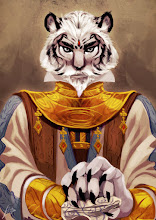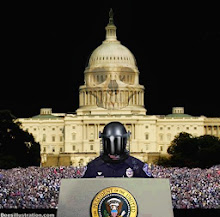06 August 2011
THE SHADOW OF THE DALAI LAMA
“The cause [of the despotism] is the invisible disease which is still there and which develops immediately if met with various conditions. And what is this disease? It is your clinging to your own power. It is a fact that even at that time if someone would have used democracy on you, you would not have been able to accept it. ... Your Holiness, you wish to be a great leader, but you do not know that in order to fulfill the wish, a ‘political Bodhisattva vow’ is required. So you entered instead the wrong ‘political path of accumulation’ (tsog lam) and that has led you on a continuously wrong path. You believed that in order to be a greater leader you had to secure your own position first of all, and whenever any opposition against you arose you had to defend yourself, and this has become contagious. ... Moreover, to challenge lamas you have used religion for your own aim. To that purpose you had to develop the Tibetan people’s blind faith. ... For instance, you started the politics of public Kalachakra initiations. Normally the Kalachakra initiation is not given in public. Then you started to use it continuously in a big way for your politics. The result is that now the Tibetan people have returned to exactly the same muddy and dirty mixing of politics and religion of lamas which you yourself had so precisely criticized in earlier times. ... You have made the Tibetans into donkeys. You can force them to go here and there as you like. In your words you always say that you want to be Ghandi but in your action you are like a religious fundamentalist who uses religious faith for political purposes.
Your image is the Dalai Lama, your mouth is Mahatma Ghandi and your heart is like that of a religious dictator. You are a deceiver and it is very sad that on the top of the suffering that they already have the Tibetan people have a leader like you. Tibetans have become fanatics. They say that the Dalai Lama is more important than the principle of Tibet. ... Please, if you feel like being like Gandhi, do not turn the Tibetan situation in the church dominated style of 17th century Europe”
-----An open letter to the Kundun written by Tibetans in exile
(Sam, May 27, 1997 - Newsgroup 16).
The shadow is the “other side” of a person, his “hidden face”, the shadows are his “occult depths”. Psychoanalysis teaches us that there are four ways of dealing with our shadow: we can deny it, suppress it, project it onto other people, or integrate it.
But the topic of the shadow does not just have a psychological dimension; ever since Plato’s famous analogy of the cave it has become one of the favorite motifs of Western philosophy. In his Politeia (The State), Plato tells of an “unenlightened” people who inhabit a cave with their backs to the entrance. Outside shines the light of eternal and true reality, but as the people have turned their backs to it, all they see are the shadows of reality which flit sketchily across the walls of the cave before their eyes. Their human attentiveness is magically captivated by this shadowy world and they thus perceive only dreams and illusions, never higher reality itself. Should a cave dweller one day manage to escape this dusky dwelling, he would recognize that he had been living in a world of illusions.
This parable was adapted by Friedrich Nietzsche in Aphorism 108 of his Fröhliche Wissenschaft [The Gay Science] and — of interest here — linked to the figure of Buddha: “For centuries after Buddha had died,” Nietzsche wrote, “his shadow was still visible in a cave — a dreadful, spine-chilling shadow. God is dead: but man being the way he is, for centuries to come there will be caves in which his shadow is shown — and we — we must also triumph over his shadow”.
This aphorism encourages us to speculate about the Dalai Lama. He is, after all, worshipped as “God” or as a “living Buddha” (Kundun), as a supreme enlightened being. But, we could argue with Nietzsche, the true Buddha (“God”) is dead. Does this make the figure of the Dalai Lama nothing but a shadow? Are pseudo-dogmas, pseudo-rituals, and pseudo-mysteries all that remain of the original Buddhism? Did the historical Buddha Shakyamuni leave us with his “dreadful shadow” (the Dalai Lama) and have we been challenged to liberate ourselves from him? However, we could also speculate as to whether people perceive only the Dalai Lama’s silhouette since they still live in the cave of an unenlightened consciousness. If they were to leave this world of illusion, they might experience the Kundun as the supreme luminary and Supreme Buddha (ADI BUDDHA).
In our study of the Dalai Lama we offer concrete answers to these and similar metaphysical questions. To do this, however, we must lead our readers into (Nietzsche’s) cave, where the “dreadful shadow” of the Kundun (a “living Buddha”) appears on the wall. Up until now this cave has been closed to the public and could not be entered by the uninitiated.
Incidentally, every Tibetan temple possesses such an eerie room of shadows. Beside the various sacred chambers in which smiling Buddha statues emit peace and composure there are secret rooms known as gokhangs which can only be entered by a chosen few. In the dim light of flickering, half-drowned butter lamps, surrounded by rusty weapons, stuffed animals, and mummified body parts, the Tibetan terror gods reside in the gokhang. Here, the inhabitants of a violent and monstrous realm of darkness are assembled. In a figurative sense the gokhang symbolizes the dark ritualism of Lamaism and Tibet’s hidden history of violence. In order to truly get to know the Dalai Lama (the “living Buddha”) we must first descend into the “cave” (the gokhang) and there conduct a speleology of his religion.
Labels:
Actuality,
Dark Force,
Facts,
Faux Spirituality,
Gods,
Human Farming,
Ideologies,
Monsters,
Philosophy,
Political Ponerology,
Religions,
Secret Societies,
Social Engineering,
Subversion,
Truth
Subscribe to:
Post Comments (Atom)






































No comments:
Post a Comment